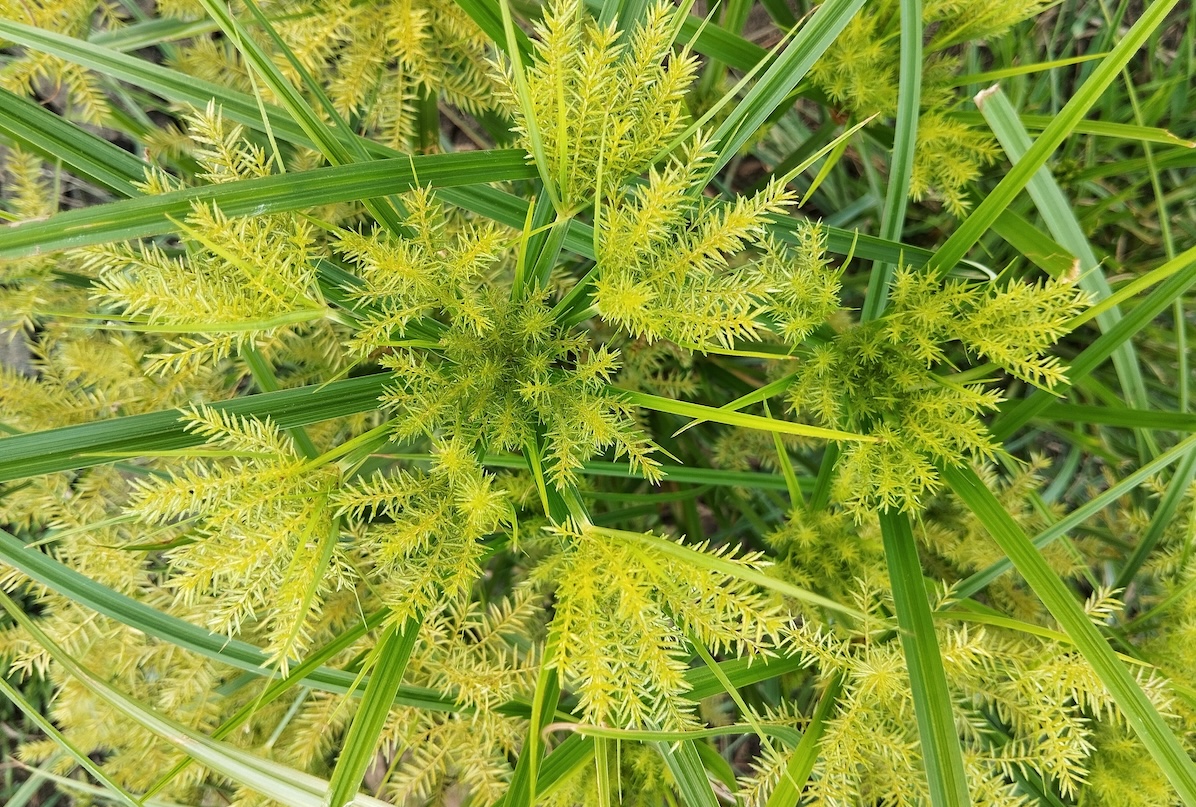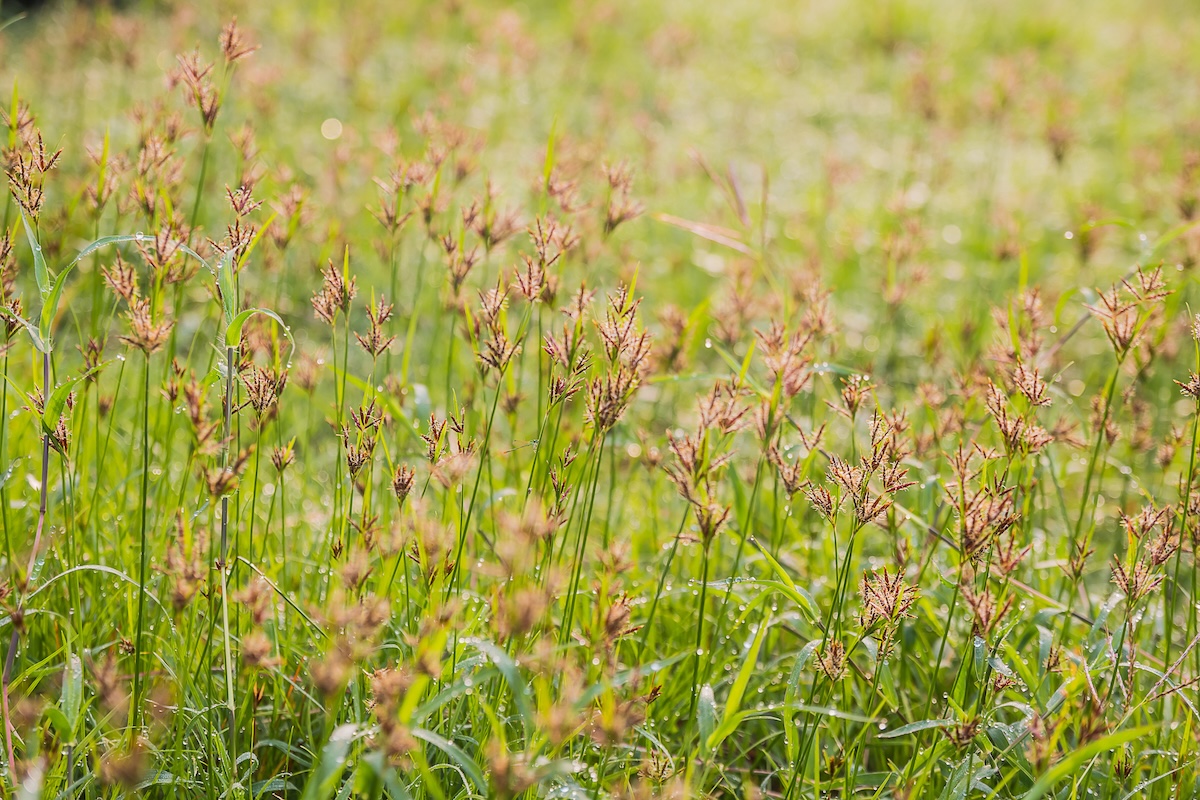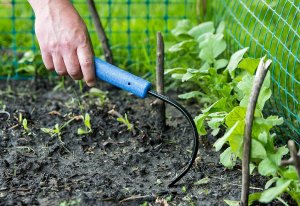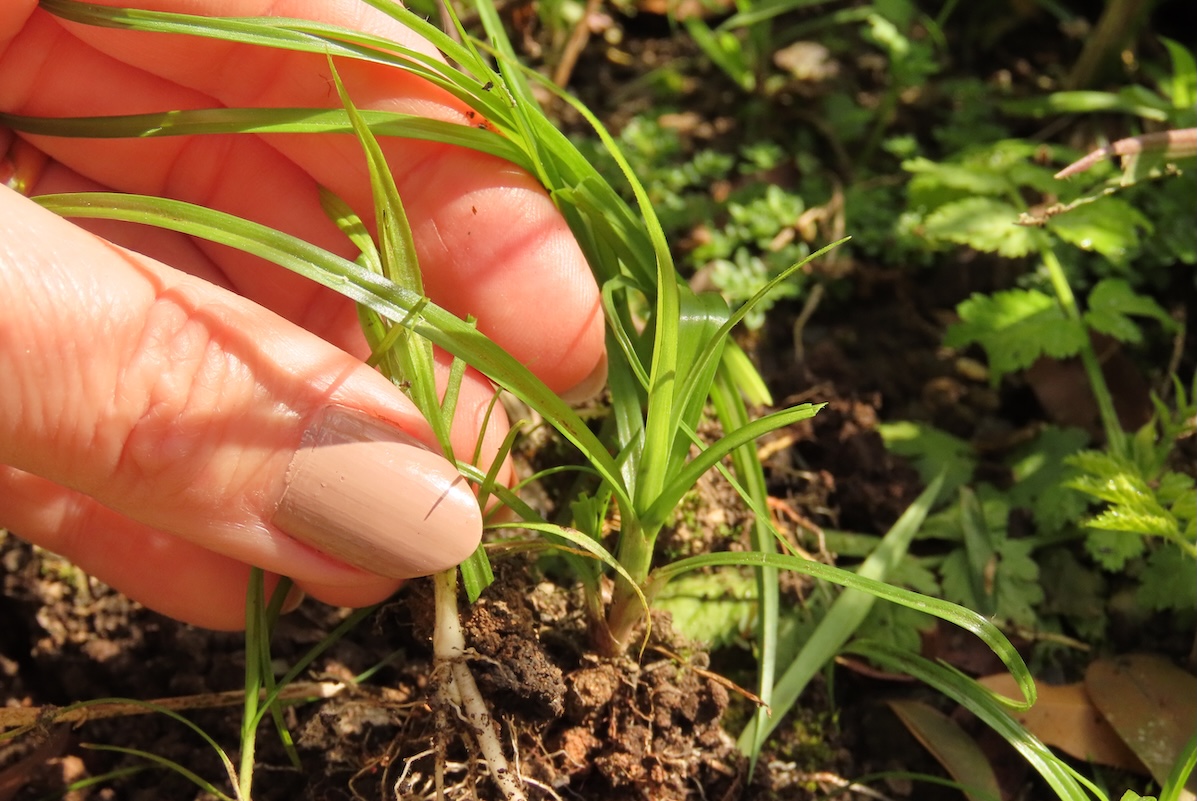

We may earn revenue from the products available on this page and participate in affiliate programs. Learn More ›
Nutsedge, also known as nutgrass, is an aggressive perennial weed. The more-widespread yellow nutsedge (Cyperus esculentus) and less-common purple nutsedge (C. rotundus) both thrive in moist soils. Controlling nutsedge is not an easy task, but it is possible to prevent it from appearing in your lawn and garden. Getting rid of nutsedge that’s already taken hold is tougher. It is possible, but requires a combination of control practices and plenty of patience.
A troublesome invader of crops and residential yards, the grass-like weed “spreads across your lawn using an underground system of stems called rhizomes, which produce tubers called ‘nutlets’,” says Dr. Roger May, director of technical operations (north) at TruGreen. The underground structure of the weed makes it difficult to control with simple pulling or other natural methods. However, May and other experts offer their tips on identifying the weed and how to get rid of nutsedge in your yard.
What is nutsedge?
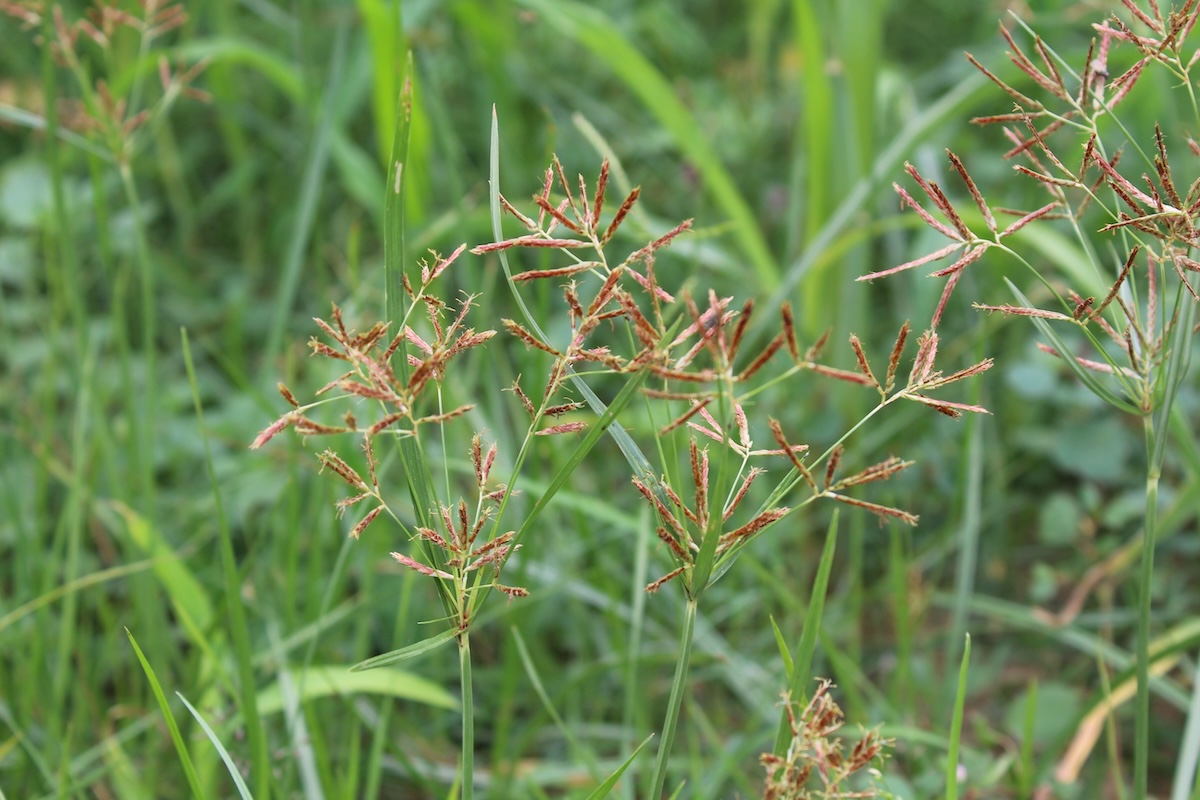
Nutsedge comes from Africa, and the tubers of the C. esculentus type—called chufa—were found in the tombs of Egyptian pharaohs. After spreading to the New World, however, nutsedge has become “one of the world’s worst weeds,” according to the Washington State Weed Control Board, which includes nutsedge on the state’s quarantine list. “Both yellow and purple nutsedge are very invasive,” says Steven Corcoran, CEO of Lawn Love.
Nutsedge tubers grow underground and sprout new plants as temperatures warm. Once a new shoot reaches the soil surface, it forms a bulb that sprouts roots with more tubers. Learning how to get rid of nutsedge begins with identifying the weed in your lawn. Although nutsedge can look like grass and blend into a lawn at first appearance, it soon outgrows your turf. “Nutsedge grows quicker in height than all lawns, so it looks unsightly, growing many inches taller than the lawn,” says Hillary Thompson, horticulturalist and communications director at Super-Sod and Soil3.
Yellow Nutsedge vs. Purple Nutsedge
“Yellow and purple nutsedge look very similar, but there are some key differences between the two,” says May. For example, yellow nutsedge tolerates cold better, so it grows in cooler or higher regions, while purple nutsedge prefers warmer climates. Identifying a weed first as nutsedge and then as purple or yellow can help you determine how to kill the nutsedge in your lawn. Here are some key characteristics of each:
| Characteristic | Yellow Nutsedge (Cyperus esculentus) | Purple Nutsedge (C. rotundus) |
| Leaf color | Light green, yellow-green | Dark green |
| Leaf tip | Long tapering | Abruptly blunt |
| Flowers | Many straw-colored flowers | Fewer dark red to purplish-brown blooms |
| Seedhead color | Yellowish-brown | Reddish-brown |
| Stem height | Taller (up to 3 feet) | Shorter (up to 1⅓ feet) |
| Cold tolerance | Tubers survive frost | Tubers die from hard frost |
| Emergence | Earlier (mid-spring to early summer) | Later (consistently 59 degrees Fahrenheit) |
| Rhizomes | Scaly | Thread-like |
| Tubers | Oblong, hairy | Smooth, spherical |
| Tuber growth | Single tuber at tip of rhizome | Multiple tubers along rhizome |
Where does nutsedge grow?
Nutsedges grow in temperate to tropical zones around the world, where they can affect irrigated crops and residential yards or gardens. Yellow nutsedge originated in subtropical areas but spread to more temperate areas, including parts of California. However, it is most problematic in the north central and northeast regions of the U.S. and can form dense stands in areas with high moisture, like disturbed wetlands. Purple nutsedge also comes from tropical or subtropical regions and is ubiquitous in the Southeast, from Virginia to central Texas.
In your lawn and garden, nutsedge can appear in nearly any kind of soil, but usually in damp areas of the yard, such as low spots in the lawn. “It grows best in moist conditions that often result or occur from poor drainage, overwatering, or excess rainfall,” says May. So, the weeds can appear in vegetable or flower gardens as well as lawns, especially where soil drains poorly. Established, more-mature nutsedges might even survive in drought or dry soil conditions.
How does nutsedge affect your lawn?
“Nutsedge will choke out your lawn,” says Corcoran. “It’s a perennial weed that will absolutely take over your grass if you don’t handle it as soon as possible,” he adds. Thompson points out that nutsedge can even outcompete dense turf like zoysia grass.
According to Angelika Zaber, lawn care specialist and gardening expert at Online Turf in the U.K., the weed’s easy spread allows it to take over lawns and other areas quickly. “Once it does, it competes for nutrients with the plants you want to grow, causing them to be weaker and more susceptible to diseases,” she says. The competition for nutrients can make your lawn look uneven and the grass look weaker and thinner. “On top of this, nutsedge can be an eyesore due to its yellowish appearance, which will stand out from the green lawn,” adds Zaber.
Ways to Control Nutsedge
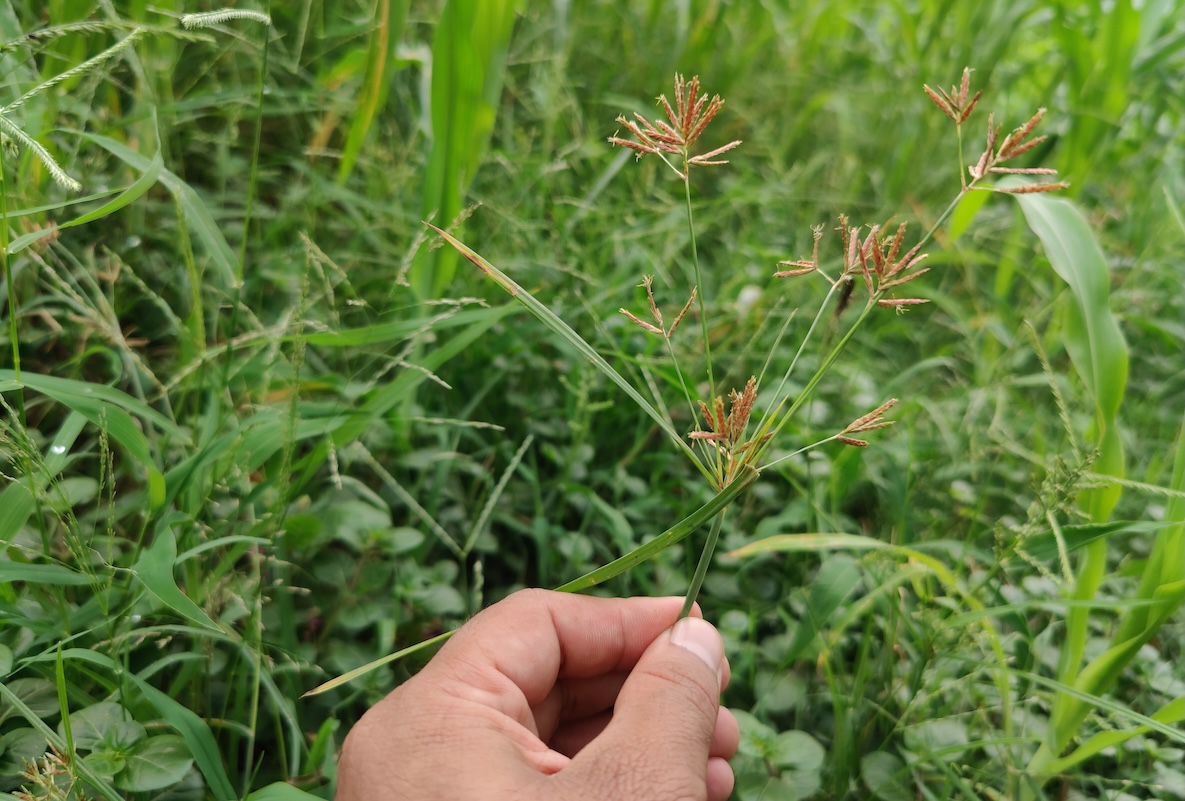
Choosing how to get rid of nutgrass depends on how prevalent the weed is in your area, whether it’s already sprouted, and where it shows up in your lawn or garden. Sedge weeds tend to spread easily, says May. “Once established, it can sometimes take a couple of years to control a heavy nutsedge population in your lawn,” he says. It’s always a good idea to start with the most natural methods and only turn to more drastic approaches (especially use of herbicides) if the weeds persist or have taken over an area of turf.
1. Use care when purchasing soil.
Often, nutsedge appears in lawns or gardens because it was present in soil brought from sites where the weed grew. Small tubers or rhizomes can hide in the soil while dormant and then sprout and grow once set in your lawn or garden bed. If you live in an area vulnerable to nutsedge, try to determine the source of soils and compost you add to your yard.
2. Aerate your lawn.
Aerating your lawn each year helps improve drainage and lessen compaction of soil. “Aerate your lawn once or twice a year as this will improve drainage, and nutsedge tends to thrive in moist, compacted soil,” says Zaber. In addition, a dense and healthy lawn can better compete with the weed for nutrients.
3. Mow your lawn more often, but at a proper height.
Although nutsedge spreads mainly by tubers on its underground rhizomes, it also can spread by seeds. According to May, proper mowing is critical to reducing the appearance of nutsedges in your lawn and to preventing the weeds from going to seed. Nutsedges generally are taller than turf, and it’s easy to see when to mow them before seeds form. Mow the grass to the height recommended for your grass type and avoid mowing it too short, because a dense and tall lawn shades and protects the soil.
4. Maintain a dense, lush lawn or garden bed.
In addition to grass height, density of your turf matters when competing with nutsedge. Fertilize as recommended for your type of grass or by your lawn care professional. “One natural way to manage nutsedge is to increase the density of your lawn by overseeding, allowing the lawn to crowd the weed out,” says Zaber. Likewise, compete with nutsedge in garden and vegetable beds if necessary by planting high densities of fast-growing plants, such as annual flowers or leafy vegetables.
5. Improve drainage and avoid overwatering.
Soil aeration is one way to improve drainage in lawns. If your lawn or garden beds have low spots or areas of compacted soil, do all you can to loosen and improve its drainage. Be sure to set timers for sprinklers, drip systems, and even when hand-watering with a hose to avoid oversaturating soil. A smart sprinkler system also can stop watering after rainfall.
6. Pull up single nutsedge plants, but don’t stop there.
In general, our experts warn that pulling a nutsedge from the ground does not work like it might with other weeds. “Pulling the weed by hand will not remove the rhizomes or tubers underground, so it will continue to sprout,” says May. If you want to try pulling first, Corcoran recommends pulling as early as possible, “before it sprouts five to six leaves.” He says at that point, a new plant has not begun producing tubers, so you might be able to halt its spread.
7. Dig or till vegetable garden beds.
Once nutsedge dies back above the ground, its nutlets and rhizomes are resting dormant under the soil. Turn or till soil in fall as part of gardenbed cleanup to spot tubers. In early spring, dig or till at 2- to 4-week intervals to expose and remove tubers before they have a chance to become viable.
Just beware that tilling can turn up other weed seeds in your garden that you might want to prevent. So, if you fail to find tubers with shallow turning or tilling, but know that nutsedge has grown nearby, take a spade and dig deeper. The nutlets can grow 8 to 14 inches beneath the surface. Light tillage or turning also loosens compacted soil in garden beds.
8. Dig up large colonies in the lawn and reseed.
Nutsedge patches can spread to nearly 10 feet in diameter. If you remove a large patch of nutsedge, you’ll be left with an equally large patch of uncovered ground. “That bare patch offers an opportunity for other weeds to get a foothold in that bare dirt, so we recommend quickly resodding or reseeding to cover the bare dirt,” says Thompson.
9. Use herbicides only as a last resort.
If you’ve tried cultural controls and digging up small patches of nutsedge tubers, you might have to turn to a selective postemergent herbicide as a last resort to kill nutsedge but not the grass around it. If you do so, you still need to spray the nutsedge foliage as soon as it’s visible and before tubers mature. Avoid mowing for about three days after spraying. Nonselective herbicides will likely kill the grass around the weed as well. The best selective herbicides for nutsedge are those that contain halosulfuron or sulfentrazone.
Preemergent herbicides are less effective with nutsedge, since much of its growth is from underground rather than from seeds. Most post-emergent herbicides approved for use on nutsedge will not kill the mature plant and you will need to reapply the spray often. “Read the label to make sure the herbicide is safe for your type of lawn and other plants” if the nutsedge has cropped up in flower beds, says Thompson. This helpful list from the Clemson College of Agriculture provides more information on herbicides that can control nutsedge.
10. Turn to a lawn care professional.
Although several specific weed control products can effectively reduce nutsedge, May recommends getting in touch with a certified lawn care specialist to manage nutsedge. Aside from pros’ knowledge of safe and appropriate chemical uses, they have more experience in knowing what kills nutsedge in the lawn or garden and opting for the safest products for the grass or other plants. If you prefer to try and get rid of nutsedge naturally first (or as the only option), be sure to communicate this to the company.
The Best Way to Get Rid of Nutsedge for Good
The best way to get rid of nutsedge is to prevent it from sprouting in your yard or to get rid of it as soon as possible once identified, before it has time to spread. “There are several things you can do to guard your lawn against the sedge weed population,” says May. He cites “creating a healthier, thicker lawn through proper fertilization, aerating, and overseeding, depending on the grass type” as the best way to control nutsedge in the yard long term.
FAQ
“It is possible to permanently get rid of nutsedge,” says Zaber. However, it takes a combination of natural and cultural methods, and potentially the use of herbicides.
It is difficult to impossible to eradicate high numbers of nutsedge plants through natural methods or homemade weed killers. However, preventing it from taking hold with the cultural methods detailed above can go a long way toward natural control. In addition, you can dig up and dispose of tubers and rhizomes, but it could take several seasons to see full results.
If you are unsure about the identification of nutsedge or have a large patch of the weed, you might be better off turning to a lawn care specialist. You can try cultural and natural methods first, and call in the pros if your efforts are failing or if you prefer not to handle chemical herbicides.
You might not be able to completely kill nutgrass in fall, but you can use this time to dig up tubers. Place a flag or other mark in the ground around the sprouted nutsedge so you can locate where to dig once the foliage dies back. Chemical herbicides will not work well in fall, since the weed’s foliage has retreated.
Although highly concentrated vinegar (10 to 20 percent acetic acid) can kill some annual weeds, it is not likely to be effective at killing the underground reproductive parts of this perennial weed. In addition, vinegar will temporarily burn grass or other foliage around the nutsedge.
Sugar will not kill nutsedge.
